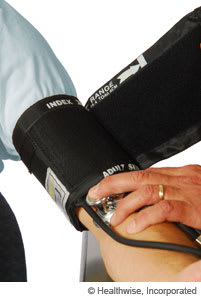Our Health Library information does not replace the advice of a doctor. Please be advised that this information is made available to assist our patients to learn more about their health. Our providers may not see and/or treat all topics found herein. Using a home blood pressure monitor lets you keep track of your blood pressure at home. Blood pressure is a measure of how hard the blood pushes against the walls of your arteries as it moves through your body. Your blood pressure is recorded as two numbers. Someone with a systolic pressure of 120 and a diastolic pressure of 80 has a blood pressure of 120/80, or "120 over 80." Blood pressure is measured in millimeters of mercury (mm Hg). Most people use an automatic monitor to measure their blood pressure at home. These are also called electronic or digital monitors. They have a microphone to detect blood moving through the artery. The cuff wraps around your upper arm. When you press the start button on the monitor, the cuff automatically inflates. Then the cuff automatically deflates, and the monitor takes your blood pressure. Health Tools help you make wise health decisions or take action to improve your health. You may check your blood pressure at home to: Follow the instructions that came with your blood pressure monitor. They might be different from the following. It is important that the blood pressure cuff is the right size for your arm: not too large and not too small. The inflatable part of the cuff can't overlap too much. But it needs to be long enough to go all the way around the widest part of your upper arm. If you will be monitoring your blood pressure at home, ask your doctor or nurse to check to make sure the cuff fits correctly. The blood pressure cuff will feel a little tight when the cuff inflates and squeezes your arm. There is little risk of any problems from this test. Your systolic and diastolic pressures are both important. Most medical guidelines say a normal blood pressure measurement is less than 120/80 mmHg. Your doctor will give you a goal for your blood pressure. Your goal will be based on your health and your age. It's normal for blood pressure to go up and down throughout the day. But if it stays up, you have high blood pressure. Your doctor may want to track the results of your blood pressure over time to see if it stays in a high or low range. In general, the lower your blood pressure, the better. For example, a blood pressure reading of less than 90/60 is healthy as long as you feel okay. Current as of: October 2, 2025 Author: Ignite Healthwise, LLC Staff Current as of: October 2, 2025 Author: Ignite Healthwise, LLC Staff Clinical Review Board This information does not replace the advice of a doctor. Ignite Healthwise, LLC disclaims any warranty or liability for your use of this information. Your use of this information means that you agree to the Terms of Use and Privacy Policy. Learn how we develop our content. To learn more about Ignite Healthwise, LLC, visit webmdignite.com. © 2024-2025 Ignite Healthwise, LLC.Home Blood Pressure Test
Test Overview
Automatic blood pressure monitors
Health Tools
Why It Is Done
How To Prepare
Before you take your blood pressure
How It Is Done
Getting a blood pressure cuff that fits

How It Feels
Risks
Results
Related Information
Credits
Clinical Review Board
All Ignite Healthwise, LLC education is reviewed by a team that includes physicians, nurses, advanced practitioners, registered dieticians, and other healthcare professionals.
All Ignite Healthwise, LLC education is reviewed by a team that includes physicians, nurses, advanced practitioners, registered dieticians, and other healthcare professionals.
Our Health Library information does not replace the advice of a doctor. Please be advised that this information is made available to assist our patients to learn more about their health. Our providers may not see and/or treat all topics found herein. Current as of: October 2, 2025 Author: Ignite Healthwise, LLC Staff Clinical Review BoardHome Blood Pressure Test
All Ignite Healthwise, LLC education is reviewed by a team that includes physicians, nurses, advanced practitioners, registered dieticians, and other healthcare professionals.



